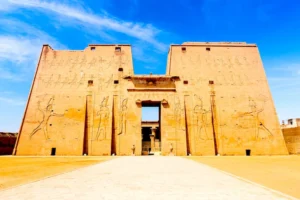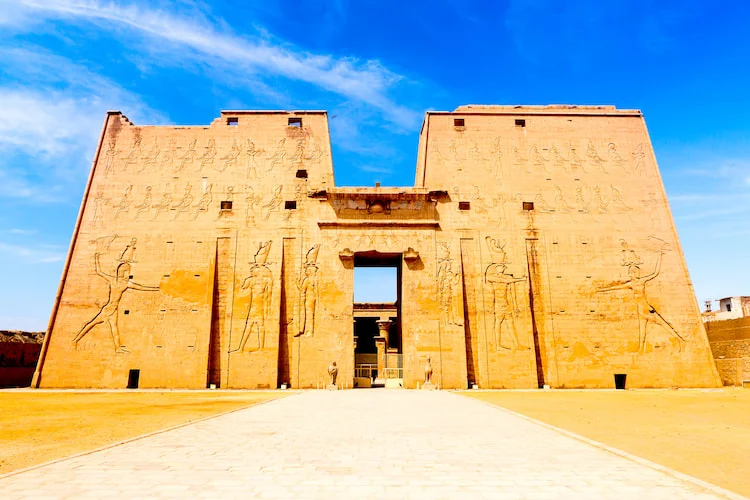Temple of Horus:A Journey Through History
Discovering the Temple of Horus: A Journey Through History and Myth
The Temple of Horus, located in Edfu, Egypt, is one of the best-preserved ancient monuments in the country. Dedicated to Horus, the falcon-headed god of the sky, kingship, and protection, this temple offers a fascinating glimpse into the religious practices, architectural brilliance, and cultural heritage of ancient Egypt. In this blog post, we will explore the Temple of Horus, making it an easy and enjoyable read for all.
1. Historical Significance
Ancient Origins
The Temple of Horus was constructed during the Ptolemaic period, between 237 and 57 BCE. It stands on the site of an earlier temple, and its construction was initiated by Ptolemy III Euergetes I and completed by Ptolemy XII Neos Dionysos. The temple was built to honor Horus, one of the most significant deities in ancient Egyptian mythology.
Religious Importance
Horus, the god of the sky, war, and hunting, protected the pharaoh and the nation. The Temple of Horus hosted major rituals, ceremonies, and festivals to honor him and seek his blessings.
2. Architectural Marvels
Grand Entrance
The Temple of Horus features a grand entrance with a massive 36-meter-high pylon, adorned with intricate carvings of the pharaoh making offerings to Horus and other gods. This impressive entrance sets the tone for the magnificence within, including the Hypostyle Hall.
Hypostyle Hall
One of the most striking features of the temple is the Hypostyle Hall, a vast space supported by 32 towering columns. The columns are decorated with elaborate carvings and hieroglyphs that tell the story of Horus and his divine lineage. The hall served as a gathering place for worshippers and a venue for important religious ceremonies.
3. Mythological Tales
The Battle of Horus and Set
The Temple of Horus is steeped in mythological tales, particularly the epic battle between Horus and his uncle Set. According to legend, Set murdered Horus’s father, Osiris, and claimed the throne of Egypt. Horus, with the help of his mother Isis, avenged his father’s death by defeating Set in a series of battles. This tale of good triumphing over evil was central to the religious beliefs of ancient Egyptians and was celebrated through rituals at the temple.
The Divine Birth
Another significant myth associated with the Temple of Horus involves the divine birth of Horus. After Isis resurrects Osiris, she conceives Horus through magical means. Horus is born in secrecy and grows up to avenge his father’s death and claim the throne as the rightful heir. The temple’s reliefs and inscriptions prominently feature this story, emphasizing the divine nature of Horus and his role as Egypt’s protector.
4. Cultural and Social Hub
Pilgrimage Site
The Temple of Horus was a major pilgrimage site for ancient Egyptians and people from neighboring regions. Pilgrims would travel long distances to seek blessings from Horus and participate in religious festivals. The temple’s strategic location along the Nile made it accessible to devotees arriving by boat.
Community Gatherings
The temple complex also served as a social and cultural hub for the local community. It was a place where people gathered for festivals, ceremonies, and communal activities. The annual “Feast of the Beautiful Meeting,” celebrating the reunion of Horus and Hathor, was one of the most important events held at the temple.
5. Modern-Day Attractions of Temple of Horus
Sound and Light Show
One of the highlights of visiting the Temple of Horus today is the mesmerizing Sound and Light Show. This evening spectacle uses cutting-edge technology to illuminate the temple’s structures while narrating the history and legends associated with the site. The show offers a captivating experience that brings the ancient world to life.
Scenic Boat Rides
To reach the Temple of Horus, visitors can take a scenic boat ride along the Nile. The journey offers stunning views of the river and the surrounding landscape, setting the stage for the awe-inspiring beauty of the temple complex. The boat ride itself is a memorable part of the Edfu experience.
6. Practical Tips for Visiting
Best Time to Visit
The best time to visit the Temple of Horus is during the cooler months from October to April. The weather is more pleasant, making it easier to explore the site comfortably. Early morning or late afternoon visits are also recommended to avoid the midday heat.
Guided Tours
To fully appreciate the history and significance of the Temple of Horus, consider joining a guided tour. Knowledgeable guides can provide valuable insights into the temple’s architecture, mythology, and cultural context, enhancing your overall experience.
Respectful Conduct
As a site of immense historical and cultural importance, it is essential to show respect while visiting the Temple of Horus. Follow the guidelines provided by the authorities, avoid touching the ancient structures, and maintain a respectful demeanor throughout your visit.
Finally
The Temple of Horus is a testament to the enduring legacy of ancient Egyptian civilization. Its rich history, architectural brilliance, and mythological significance make it one of the most captivating sites in Egypt. Whether you are a history enthusiast, a mythology buff, or simply seeking a unique cultural experience, a visit to the Temple of Horus promises to be an unforgettable journey through time. Explore the wonders of this ancient sanctuary and immerse yourself in the timeless stories that continue to inspire and captivate visitors from around the world.








